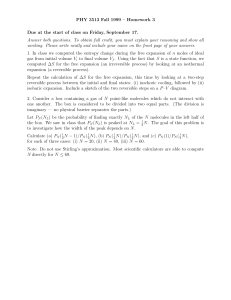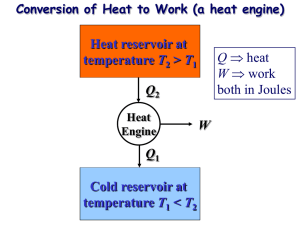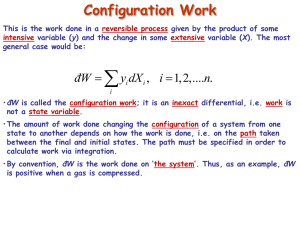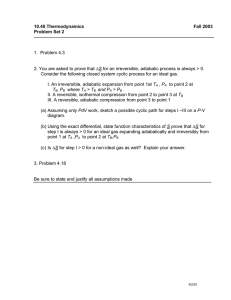5.60 Thermodynamics & Kinetics
advertisement
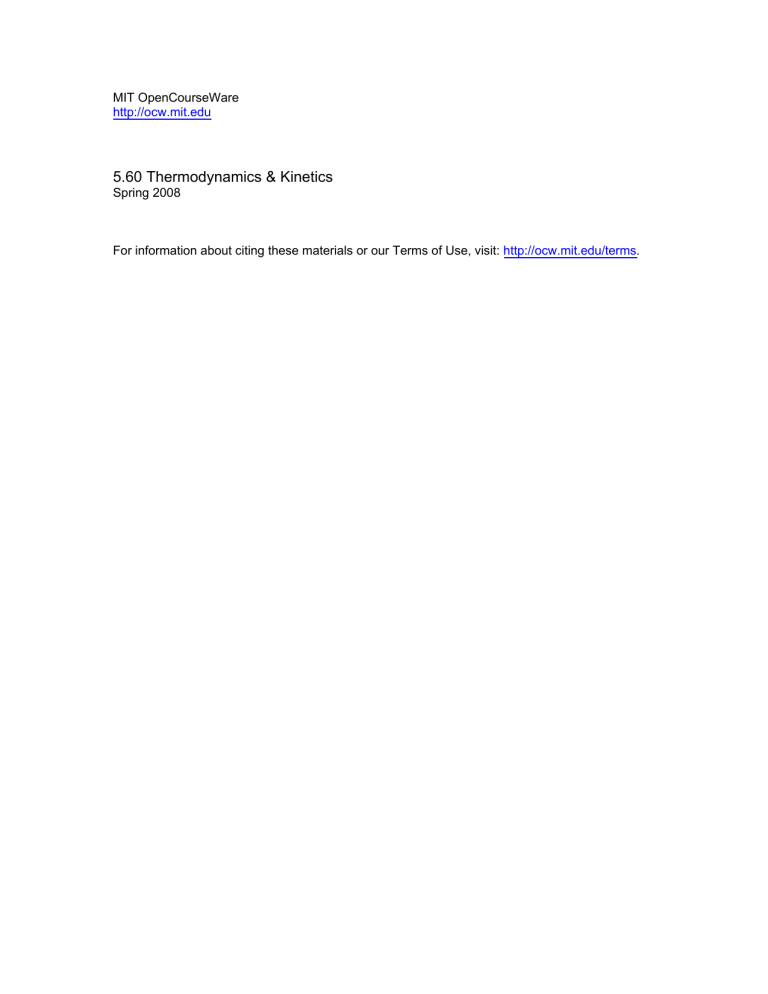
MIT OpenCourseWare http://ocw.mit.edu 5.60 Thermodynamics & Kinetics Spring 2008 For information about citing these materials or our Terms of Use, visit: http://ocw.mit.edu/terms. 5.60 Spring 2008 Lecture #9 page 1 Entropy • For a reversible ideal gas Carnot cycle: Efficiency −w ε= qrev q1 q2 + =0 ⇒ T1 T2 ⇒ • q2rev T = 1 + rev = 1 − 2 q1 T1 v∫ đqrev T =0 The efficiency of any reversible engine has to be the same as the Carnot cycle: T1 (hot) ε= q1 w Some reversible engine w q2 q2 T2 (cold) Carnot cycle ( −w ) q1 ε′ = ( −w ′ ) q1′ Assume ε ′ > ε (left engine less efficient than Carnot cycle) Since the engine is reversible, we can run it backwards. Use the work (-w’) out of the Carnot engine as work input (w) to run the left engine backwards. ∴ Total work out = 0 (-w’ = w > 0) But ε ' > ε ⇒ −w ′ −w > q1′ q1 ⇒ w −w w > = q1′ q1 −q1 ⇒ ⇒ q1 < −q1′ since q1 < 0, q1′ > 0 − (q1′ + q1 ) > 0 This contradicts the 2nd law (Clausius). This says that we have a net flow of heat into the hot reservoir, but no work is being done! ∴ The efficiency of any reversible engine is ε = 1 − T2 T1 5.60 Spring 2008 Lecture #9 page 2 • We can approach arbitrarily closely to any cyclic process using a series of only adiabats and isotherms. ∴ For any reversible cycle • This defines Entropy, a function of state dS = Note: • đqrev T v∫ đqrev ΔS = S2 − S1 = ⇒ ∫ 2 1 đqrev T Entropy is a state function, but to calculate ΔS requires a reversible path. An irreversible Carnot (or any other) cycle is less efficient than a reversible one. p 1 1→2 ( −w )irrev < ( −w )rev ⇒ wirrev > wrev irreversible isotherm with pext = p2 ΔU = qirrev + wirrev = qrev + w rev 2 adiabat 4 ** =0 T adiabat isotherm (rev.) ∴ 3 qirrev < qrev An irreversible isothermal expansion requires less heat ** than a reversible one. ε irrev also q2rev q2rev = 1 + irrev < 1 + rev = ε rev q1 q1 đqirrev đqrev T < T ⇒ v∫ đqirrev T (q2 < 0) <0 5.60 Spring 2008 Lecture #9 • Leads to Clausius inequality đq page 3 ≤0 v∫ T ⎧ đqrev ⎪⎪ v∫ T = 0 contains ⎨ ⎪ đqirrev < 0 ⎪⎩ v∫ T The entropy of an isolated system never decreases (A) irreversible 1 (A): The system is isolated and irreversibly (spontaneously) changes from [1] to [2] 2 (B) reversible (B): The system is brought into contact with a heat reservoir and reversibly brought back from [2] to [1] qirrev = 0 Path (A): Clausius đq ≤0 v∫ T ⇒ ∫ 1 2 đqrev T ∴ ⇒ (isolated) ∫ 2 1 đqirrev =0 ! T +∫ 1 đqrev 2 T ≤0 = S1 − S2 = −ΔS ≤ 0 ΔS = S2 − S1 ≥ 0 This gives the direction of spontaneous change! For isolated systems 1 2 But! ΔSsurroundings ΔS > 0 Spontaneous, irreversible process ΔS = 0 Reversible process ΔS < 0 Impossible ΔS = S2 − S1 independent of path depends on whether the process is reversible or irreversible 5.60 Spring 2008 (a) Lecture #9 page 4 Consider the universe as an isolated system containing our initial system and its surroundings. Irreversible: ΔSuniverse = ΔSsystem + ΔSsurroundings > 0 ΔSsurr > −ΔSsys ∴ (b) Reversible: ′ =0 ΔSuniv = ΔSsys + ΔSsurr ′ = −ΔSsys ΔSsurr ∴ Examples of a spontaneous process T1 Connect two metal blocks thermally in an isolated system (ΔU = 0) T2 Initially T1 ≠T2 dS = dS1 + dS2 = đq1 T1 − đq2 T2 = đq1 (T2 −T1 ) TT 1 2 ( đq1 = −đq2 ) dS > 0 for spontaneous process ⇒ if T2 >T1 T2 <T1 gas V vac. V ⇒ ⇒ đq1 > 0 đq1 < 0 in both cases heat flows from hot to cold as expected Joule expansion with an ideal gas 5.60 Spring 2008 Lecture #9 1 mol gas (V,T) ΔU = 0 adiabatic = q=0 page 5 1 mol gas (2V,T) w=0 Compress back isothermally and reversibly ΔS = − ΔSbackwards qrev ≠ 0 1 mol gas (2V,T) = 1 mol gas (V,T) ΔSbackwards = ∴ ∫ đqrev T = −∫ ΔS = R ln2 > 0 đw T = V ∫V 2 RdV 1 = R ln V 2 spontaneous Note that to calculate ΔS for the irreversible process, we needed to đq find a reversible path so we could determine đqrev and ∫ rev . T


